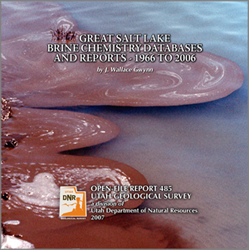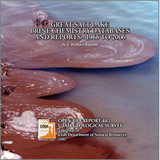Great Salt Lake brine chemistry database and reports - 1966 to 2006 (OFR-485)
By: J. W. Gwynn
Prior to the construction of the solid rock-fill railroad causeway across the central part of Great Salt Lake in 1959, the water was able to mix throughout the lake. Through this mixing, the salinity and chemistry were relatively constant both vertically and laterally. After the causeway’s completion in 1959, the main body of the lake was physically divided into a north arm and a south arm. As a result of this division, the north arm of the lake became much more saline than the south arm, and the south arm became density stratified.
This report presents the post-1966 brine density and chemistry data that have been collected by the Utah Geological Survey (UGS) through its Great Salt Lake brine collection and analysis program. Chemical and density analyses have been run on Great Salt Lake brine since the early-to-mid 1800s. These data, gleaned from the literature, are also presented. The UGS brine-sampling program began in 1966, and has run continuously to the present time. The databases resulting from this work contain several thousand chemical analyses and density values.
Other Information:
Published: 2006
Pages: 7 p. + 11 p. appendix
Location: Box Elder, Davis, Salt Lake, Tooele, and Weber Counties







